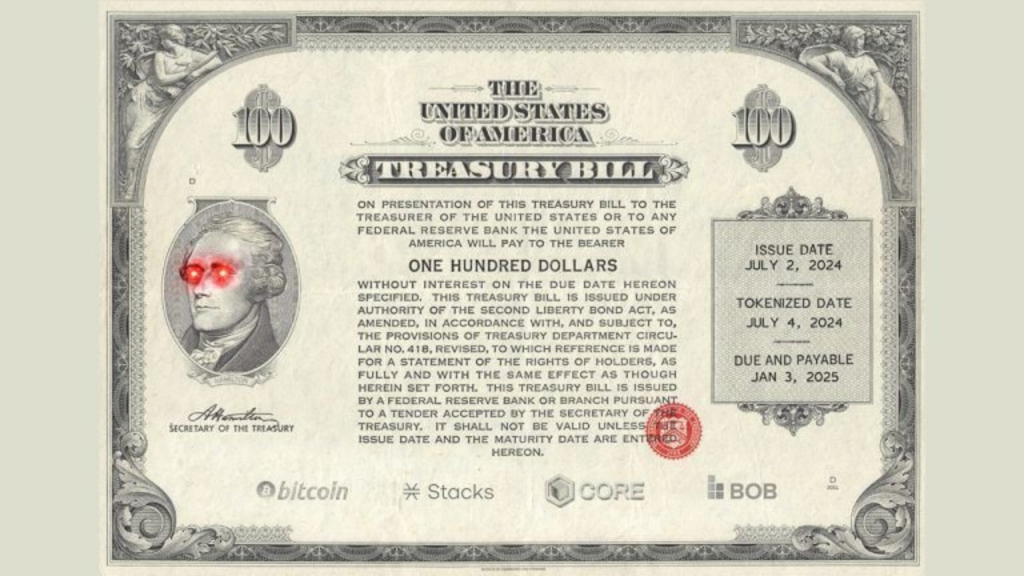Hamilton, a pioneering startup in real-world asset (RWA) tokenization, has announced a groundbreaking achievement: the tokenization of US Treasury bills on Bitcoin layer-2 (L2) solutions, including Stacks, Core, and BoB. This development marks a significant stride toward integrating traditional finance with the Bitcoin ecosystem, enhancing the accessibility and tradability of stable, government-backed assets within decentralized finance (DeFi) networks.
Hamilton’s inaugural transaction, conducted on America’s Independence Day, symbolizes a new era for financial instruments. By making Treasury bills more accessible and tradable within Bitcoin’s DeFi ecosystems, Hamilton aims to bridge the gap between traditional finance and the burgeoning world of cryptocurrency.
“Combining US Treasury bills with Bitcoin’s security and transparency marks a historic step towards financial independence, providing crucial exposure to emerging markets,” said Kasstawi, CEO & Co-founder of Hamilton.
Hamilton’s tokenized Treasury bills will be available on three prominent Bitcoin L2 solutions: Stacks, Core, and BoB. These platforms are renowned for enhancing Bitcoin’s scalability and functionality, making it easier and more affordable to create digital tokens representing real-world assets. With Bitcoin’s robust security framework, these tokenized Treasury bills are expected to become a significant asset on Hamilton’s platform.
This initiative aligns with the growing interest in RWA tokenization from both crypto firms and traditional financial institutions. The Boston Consulting Group (BCG) projects the RWA market to reach a staggering $16 trillion by 2030, underscoring the immense potential of such innovations.
The latest data from RWA.xyz highlights the rapid growth of the tokenized treasuries market. As of July 4, the total value of tokenized treasuries stands at $1.79 billion, representing a 215.88% year-on-year increase from $566.67 million. This surge in value reflects the rising demand and potential for RWA tokenization within the financial sector.

Hamilton’s venture into tokenizing US Treasury bills on Bitcoin’s L2 solutions not only showcases the potential for traditional assets to be integrated into the cryptocurrency space but also highlights the increasing sophistication and maturity of the DeFi market. This move is poised to attract more institutional interest, fostering a deeper connection between traditional financial markets and the innovative world of blockchain technology.
The tokenization of US Treasury bills on Bitcoin’s L2 solutions is a pivotal development for several reasons. By tokenizing Treasury bills, Hamilton makes these stable, government-backed assets more accessible to a broader range of investors within the DeFi space. This democratizes access to traditionally exclusive financial instruments. Tokenized assets can be traded more easily and quickly than their traditional counterparts, enhancing liquidity in the financial markets. This is particularly beneficial for assets like Treasury bills, which are typically considered highly stable but not easily tradable.
This initiative represents a significant step towards integrating traditional financial assets with the decentralized, transparent nature of blockchain technology. It bridges the gap between the old and new financial systems, offering benefits from both worlds. Leveraging Bitcoin’s renowned security and transparency ensures that tokenized assets maintain high standards of integrity and trust. This is crucial for attracting institutional investors who require robust safeguards for their investments.
The projected growth of the RWA market to $16 trillion by 2030 and the current surge in tokenized treasuries indicate a significant shift in how financial assets are perceived and traded. Hamilton’s early entry into this market positions it as a leader in the field, with substantial growth potential.
Hamilton’s successful tokenization of US Treasury bills on Bitcoin L2 solutions sets a precedent for other financial instruments to follow. As the RWA tokenization sector continues to evolve, we can expect to see more traditional assets being integrated into the blockchain ecosystem, further blurring the lines between conventional finance and the innovative world of cryptocurrency. This initiative is not just about making financial instruments more accessible; it’s about redefining the future of finance. By leveraging the power of Bitcoin’s L2 solutions, Hamilton is paving the way for a more inclusive, transparent, and efficient financial system.
















